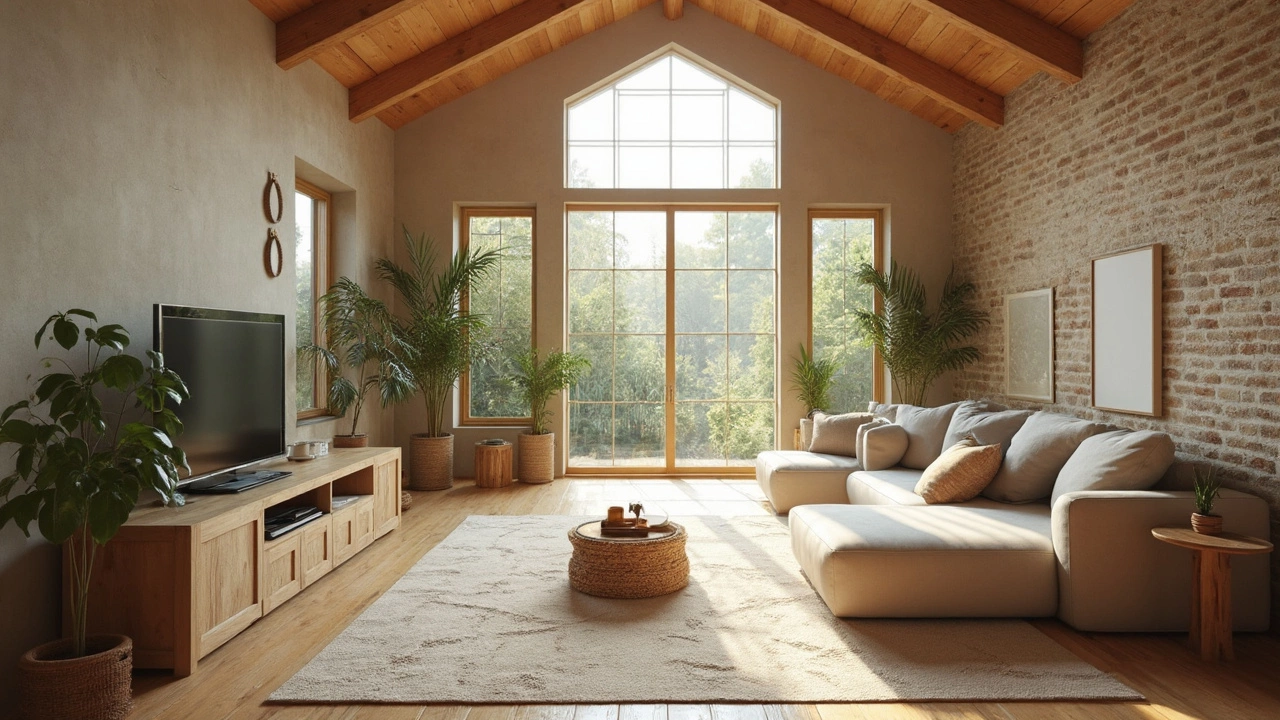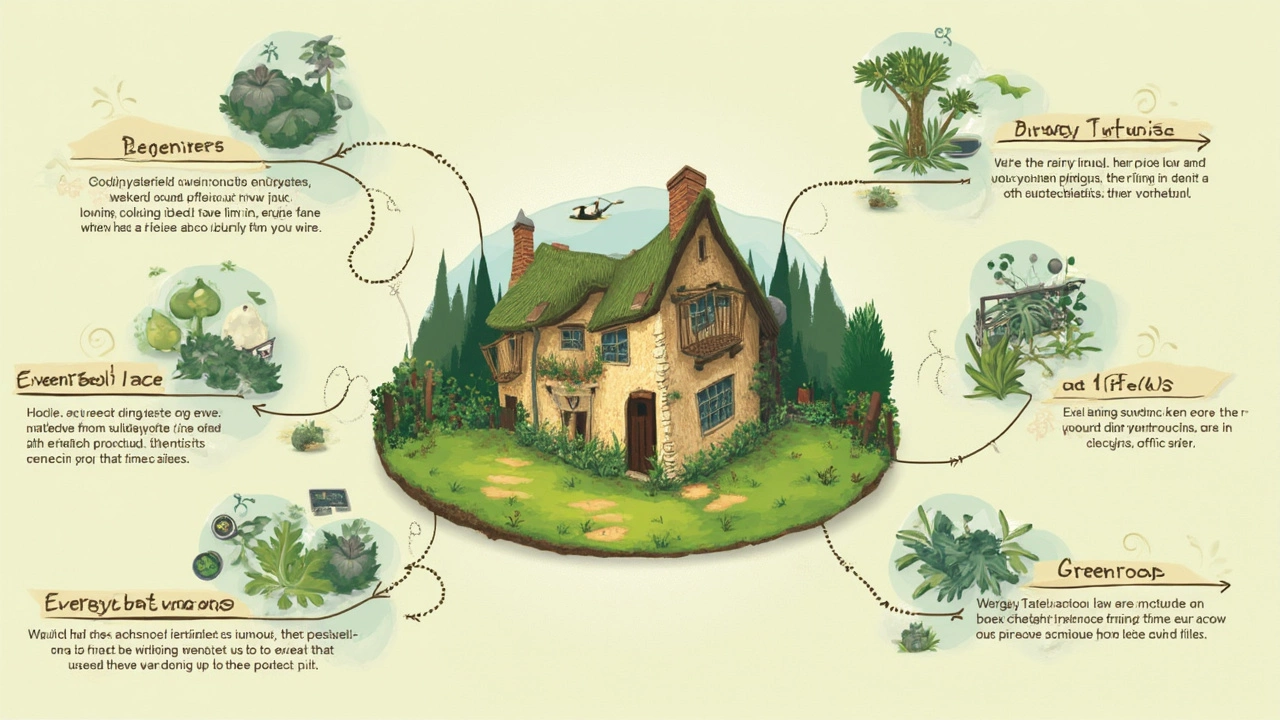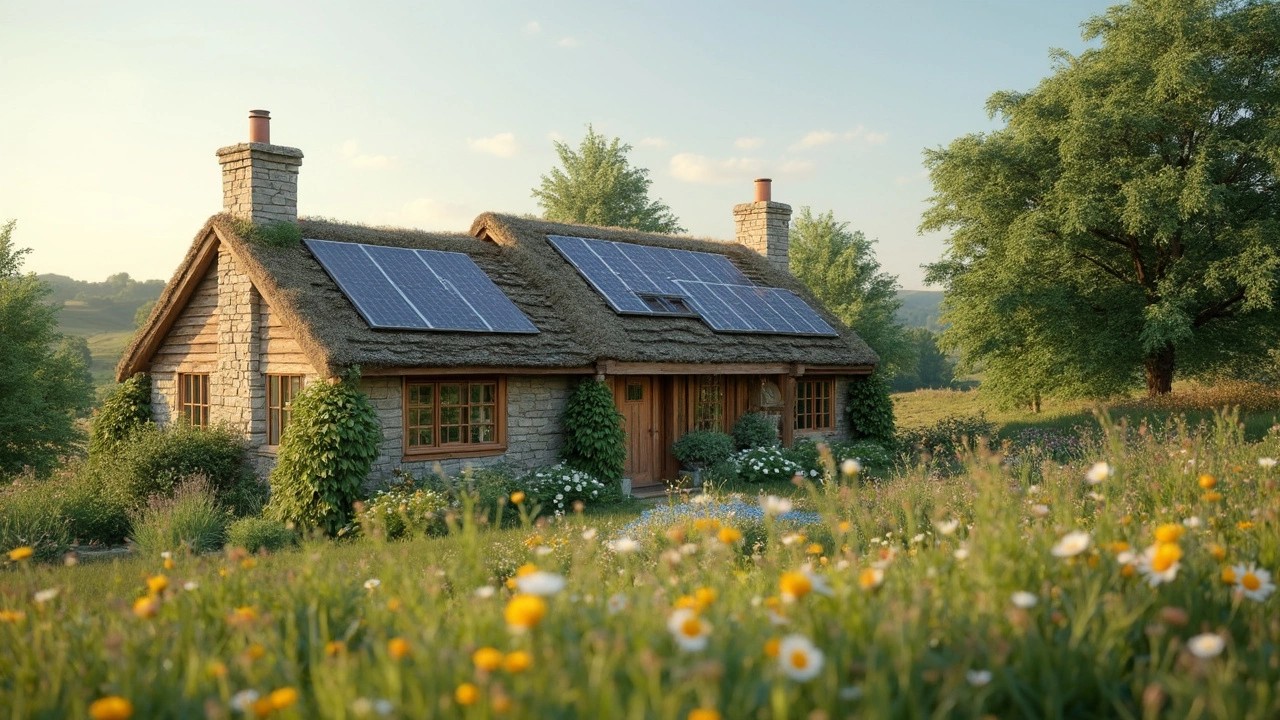If you want the most eco-friendly home, forget flashy gadgets or expensive green labels—it's all about smart planning, honest materials, and a dose of common sense. The most sustainable cottages don’t just sit in pretty nature—they work with nature too. Think about it: How much energy does your home waste? What was your wood, stone, or insulation doing before it became part of a wall? Every choice stacks up.
People often get caught up in the idea that you have to spend loads of money to go green, but some of the best eco cottages use age-old tricks. Use what’s right under your feet: local wood, stone, or even straw. Homes built from these materials usually need way less energy, both during construction and for heating or cooling later. Plus, they look like they actually belong in the landscape—not like a spaceship that crash-landed in the woods.
The easiest wins? Good insulation, smart window placement, and building small instead of sprawling. You don’t need high-tech solar roofs if you can hold onto heat and light naturally. Want your place to stay cool in summer? Overhangs or old-school shutters work without using any energy at all. Eco-friendly isn’t a style or a sign for your driveway—it’s about choosing what makes sense for the planet and for your own daily comfort.
- What Makes a Home Truly Eco-Friendly?
- Natural Materials: Wood, Straw, and More
- Smart Design for Lower Impact
- Tech and Tools for Green Living
- Pitfalls: What to Avoid on Your Eco Journey
What Makes a Home Truly Eco-Friendly?
When most people picture an eco cottage, they imagine solar panels, composting toilets, or a green roof brimming with wildflowers. Those are great, but the real test of a sustainable home goes deeper than surface features. The big questions are: how much energy goes into making and running your house, where do materials come from, and how do you deal with waste?
The full environmental impact of a house covers everything from how it’s built to how it works for decades. Builders think about something called "embodied energy"—that’s basically all the energy that goes into making the building materials and putting them together. Using local stuff—like timber from a nearby sawmill or stone from the region—slashes transport emissions and keeps your footprint small.
Another key bit: size matters. Smaller homes use less stuff to build, need less energy to heat and cool, and force you to keep only what you actually use. Think of it as quality over quantity. You’ll also save big on bills. The eco-friendly cottages that stand out usually nail three basics:
- Efficient insulation: Keeps warmth in when it’s cold, throws heat out when it’s hot. Good insulation means you’ll barely have to touch a thermostat.
- Simple design: Big south-facing windows (in the northern hemisphere) grab free sunlight, while smart shading keeps out the summer scorch.
- Low-impact construction: Avoiding plastics, concrete, and exotic materials where you can. These materials churn out a ton of carbon to produce.
Let’s take a look at how green building choices compare:
| Building Material | Average CO2 (kg/m2) | Commonly Used For |
|---|---|---|
| Concrete | 120-180 | Foundations, walls |
| Local Timber | 15-40 | Frames, cladding |
| Straw Bale | 8-15 | Walls, insulation |
Water and waste also make a big difference. Collecting rainwater, reusing greywater, or having a composting toilet might seem like small tweaks, but over years, those choices add up. The less you rely on outside grids—power, water, or sewage—the better you do on the eco scorecard.
Natural Materials: Wood, Straw, and More
When it comes to eco-friendly cottages, your building materials can make or break your sustainability goals. The best choices are often the simplest—stuff like wood, straw, and clay. These materials not only have a low carbon footprint, but they’re also totally renewable if sourced right.
Wood is the most popular option for a reason. If you use timber from certified forests, you’re helping support forests that get replanted instead of cut and abandoned. Plus, wood stores carbon for as long as your cottage stands. According to the Forest Stewardship Council, “Timber homes built from well-managed forests actually take carbon out of the atmosphere instead of releasing it.”
"Choosing timber or other local materials is one of the simplest ways to cut your home’s carbon footprint instantly." – Forest Stewardship Council
Straw bale houses might sound odd if you’ve never lived near a farm, but they’re incredibly effective at keeping your place warm in winter and cool in summer. The thick straw walls are a natural insulator, so you use less energy heating or cooling. And because straw is an agricultural byproduct, you’re actually making good use of something that might otherwise just be burned or tossed.
Don’t ignore other simple options like clay or stone. Cob cottages (using a mix of clay, sand, straw, and water) can last for generations. Stone cottages also have major staying power, plus they blend in with the landscape naturally. What you want to watch out for is how far your materials have to travel. Local always beats imported when you’re thinking about emissions from transportation.
- Source wood certified by FSC or a similar group.
- Use straw bales with a weather-resistant finish.
- Look for reclaimed brick or stone when possible.
- Check if your area has active clay or earth building groups—community projects can keep costs low.
Here’s a simple breakdown of popular eco-friendly building materials and their average energy use per ton during production:
| Material | Energy Used (kWh/ton) |
|---|---|
| Straw Bale | 40 |
| Timber (softwood) | 750 |
| Clay Brick | 2500 |
| Concrete | 5100 |
| Steel | 20000 |
Bottom line: if you stick to natural, local, and minimally processed materials, you’ll shrink your cottage’s impact on the planet without complicating your build.

Smart Design for Lower Impact
The way you design a home probably does more for the planet than any fancy product could. Good eco cottages aren’t just about what they’re made from—they’re about how you put the puzzle together. Get this part right, and you’ll waste less energy, use fewer resources, and actually enjoy living in the place.
One core principle: keep it small. A smaller footprint automatically uses fewer materials and takes less to heat or cool. It’s simple—the less space you have, the less you waste. And then there’s layout. For example, orienting windows to face south (in the Northern Hemisphere) maximizes free sunlight in winter, slicing your heating bills. Shading those same windows in summer stops your home from feeling like an oven.
“Passive solar design can reduce heating and cooling energy use by up to 70% when done well,” says the U.S. Department of Energy.
Let’s talk insulation. Most older homes leak air like sieves. A well-insulated cottage with no-fuss, modern windows can hold onto heat far better—and save you hundreds each year on bills. And hey, it’s no fun shivering through winter in a drafty place.
- Seal air gaps around doors and windows.
- Add thick insulation to walls, floors, and the roof—natural materials like sheep’s wool or cellulose work great.
- Use double- or triple-glazed glass in your windows.
Natural ventilation also matters. Position your windows so you catch cross-breezes. This makes stuffy air a thing of the past and reduces how often you need to run a fan or an AC unit. Think about including roof overhangs or porches to keep heavy sun out but still let in daylight.
Want your eco-friendly cottages to last? Gutter rainwater into barrels for watering the garden. Use composting toilets if you’re off-grid. All these design moves stack up for big wins, especially if you plan them before the builder ever swings a hammer.
| Design Feature | Potential Energy Savings |
|---|---|
| Passive Solar Orientation | Up to 50% |
| Super-Insulation | 15-40% |
| Natural Ventilation | 10-30% |
At the end of the day, every bit of design that cut corners on energy comes back to help your wallet—and the world—year after year.
Tech and Tools for Green Living
Let's get real—no one wants to freeze in winter or overheat in summer just to save the planet. But you don’t need a fortune or a Ph.D. to make your eco-friendly cottages smarter and more efficient. Picking the right gadgets and upgrades can drop your bills and shrink your footprint faster than you think.
If you’re starting simple, swap out old light bulbs for LEDs. These use at least 75% less energy and can last up to 25 times longer than old-school bulbs. Next up, smart thermostats. They learn your daily routine and heat or cool rooms only when you need it—no more running the heater all day while you’re out.
Got a good roof or a sunny spot? Solar panels might be worth it. They're not for everyone (especially in cloudy spots), but they can knock hundreds off your annual power costs. Some folks even sell extra energy back to the grid. If you’re curious about what all these choices can mean for your energy bills, here's a quick comparison:
| Upgrade | Average Energy Savings | Estimated Payback |
|---|---|---|
| LED Lights | Up to 75% | 1-2 years |
| Smart Thermostat | 10-12% | 2-3 years |
| Solar Panels (4kW) | 30-50% | 7-10 years |
Rainwater harvesting can be a huge win, too—install a barrel under your gutter to collect rain. Use that free water for your garden or even for flushing toilets (with some plumbing tweaks). Less water from the tap means less work for treatment plants and lower bills for you.
Get nerdy with electricity monitors. Plug them in and see exactly which appliances are guzzling power. You may be shocked by what’s driving your electricity bill up—a single old fridge can use more than the rest of your cottage combined.
Don’t forget about indoor air quality. Heat recovery ventilators pull in fresh air without throwing away your home’s warmth. They’re a game changer, especially in tightly built cottages that tend to get stuffy.
Bottom line: You don’t have to go all-in on tech, but picking a few smart tools can make living green a whole lot easier—and a lot more comfortable.

Pitfalls: What to Avoid on Your Eco Journey
It’s easy to get swept up in the hype around anything labeled green, but there are some big traps to watch for. First, don’t fall for greenwashing—when companies slap eco labels on stuff that’s not actually sustainable. Just because a product has a leaf on the box doesn’t make it better for the planet. Check certifications if you can, and ask questions about where and how materials are sourced.
Bigger isn’t greener. Loads of people think they’re doing the climate a favor by building a giant eco-friendly cottage. Nope. The smaller the footprint, the less energy and resources used. Stick to what you actually need and avoid the space that ends up as storage for stuff you don’t even use.
Imported so-called green materials are another minefield. Bamboo grown halfway across the world and shipped to your backyard loses most of its eco points on the journey. Local is almost always better. Pay attention to lifecycle: What will your materials be doing in 30 or 50 years? Can they be recycled or will they just end up as landfill?
Don’t blow your budget on tech you don’t need. Spending big money on fancy solar panels or heat pumps won’t fix leaky windows and bad insulation. Here’s a quick comparison showing real paybacks:
| Improvement | Average Payback Period (Years) | Energy Savings |
|---|---|---|
| Extra insulation | 2-4 | Up to 30% |
| Solar panels | 8-12 | 15-25% |
| Energy efficient windows | 5-10 | 10-20% |
Chasing trends is risky too. Eco-friendly doesn’t mean you need the latest gadget. Sometimes the classic ways—like thick curtains, draft stoppers, or even a south-facing wall—work best. And don’t ignore maintenance. If your eco cottage falls apart in a decade because of poor quality or neglect, you’re right back to square one.
The heart of true eco-friendly cottages is simple: Steer clear of shortcuts, question the hype, and focus on what works for your place, your budget, and the planet. If it sounds too good to be true, it probably is.
